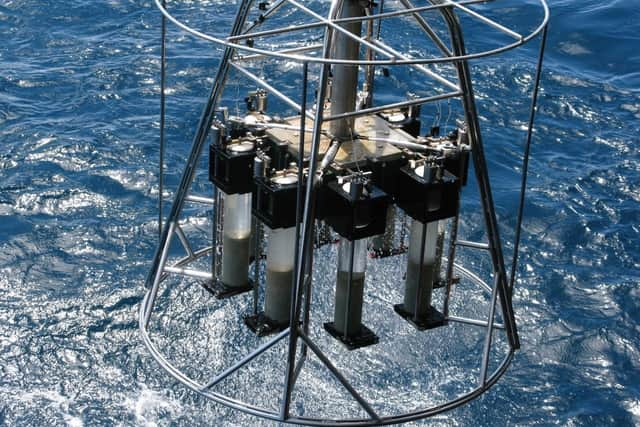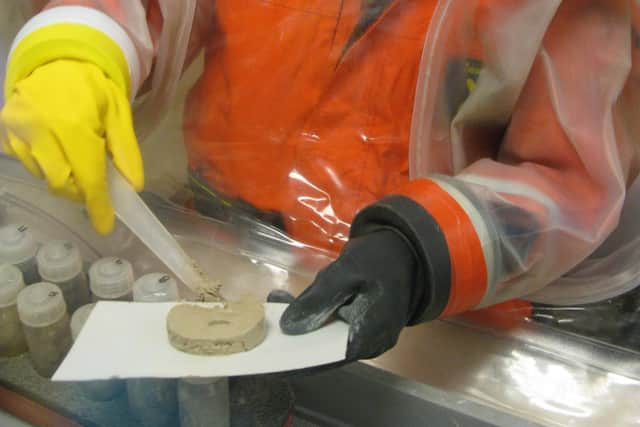How a Yorkshire scientist's deep sea discovery may help protect the food chain
The 40-year-old academic fellow from the University of Leeds' school of earth and environment set sail from Cape Town, South Africa on The RRS James Cook in 2012 as part of an international team.
His six-week expedition included travelling deep into the Roaring Forties, the stormy latitudes in the Southern Ocean, where the winds blow consistently in circles.


Advertisement
Hide AdAdvertisement
Hide AdAnd continuing until the Uruguayan continental margin - the edge of the South American continent which rises up from the very deep sea floor and eventually finds its way into the city of Montevideo in Uruguay.
In the South Atlantic Ocean Dr Homoky and the research team took sediment samples at water depths ranging from 60m (196ft) down to 5km (3.1 miles).
Now nine years on the research has revealed eroded seabed rocks are providing an essential source of nutrition for drifting marine organisms at the base of the food chain.
The findings show that iron – an essential nutrient for microscopic marine algae, or phytoplankton – is being released from sediments on the deep ocean floor.


Advertisement
Hide AdAdvertisement
Hide AdThe research shows that contrary to the expectation that oxygen in the deep-sea prevents dissolved iron from escaping the seafloor, a combination of oxygen and organic matter may actually encourage the release of iron from sediments into the ocean.
Dr Homoky said: “Our findings reveal that the shallow surface of the deep seafloor provides an important source of iron – a scarce micronutrient – for the ocean.
“We show that the degradation of rock minerals with organic matter and oxygen is a recipe to produce tiny rust particles, which are small enough to be dissolved and carried in seawater.
“These tiny rust particles and their chemical signatures explain how iron found in large parts of the ocean interior could have come from deep ocean sediments, in a manner which was once thought to be practically impossible.”


Advertisement
Hide AdAdvertisement
Hide AdResearchers say the study could influence future approaches to studying the ocean carbon cycle and managing the marine environment.
Dr Homoky said: “Our findings here are significant, because they mark a turning point in the way we view iron supply from sediments and its potential to reach marine life that paves a new way of thinking about the seafloor.
“Our discovered production of iron colloids is different to other forms of iron supplied to the ocean, and will help us design a new generation of ocean models to re-evaluate marine life and climate connections to the seafloor – where large uncertainty currently exists.
“This could help us to better understand how iron in the ocean has contributed to past productivity and climatic variations and inform our approaches to marine conservation and management.”


Advertisement
Hide AdAdvertisement
Hide AdThe research team analysed tiny and precise variations within the fluid content of sediment samples collected from the South Atlantic Ocean.
They aimed to understand how the chemical - or isotope - signatures of nano-sized iron in the sediment fluids had been formed, and what this tells us about iron supply processes to the ocean.
The findings will help shape further study of the processes that regulate the occurrence of iron in the world’s oceans and the role they play in moderating marine life and atmospheric carbon dioxide.
With the future goal of the research to learn how far iron travels and how much of it nourishes our marine food webs around the globe.
Advertisement
Hide AdAdvertisement
Hide AdReport co-author Dr Tim Conway, an assistant Professor at University of South Florida, said: "We can now measure tiny but important variations in the chemical make-up of
seawater that were beyond our reach a decade ago.
“Here we have characterised an isotope signature belonging to the iron colloids produced in deep ocean sediments that we can use to trace their journey in the ocean."
The international research team also included scientists from the universities of Southampton, Liverpool, Oxford, South Florida and Southern California.
The findings were published in the journal Proceedings of the National Academy of Science of the USA (PNAS).
__________
Support The Yorkshire Post and become a subscriber today.
Advertisement
Hide AdAdvertisement
Hide AdYour subscription will help us to continue to bring quality news to the people of Yorkshire. In return, you'll see fewer ads on site, get free access to our app and receive exclusive members-only offers. Click here to subscribe.
Comment Guidelines
National World encourages reader discussion on our stories. User feedback, insights and back-and-forth exchanges add a rich layer of context to reporting. Please review our Community Guidelines before commenting.